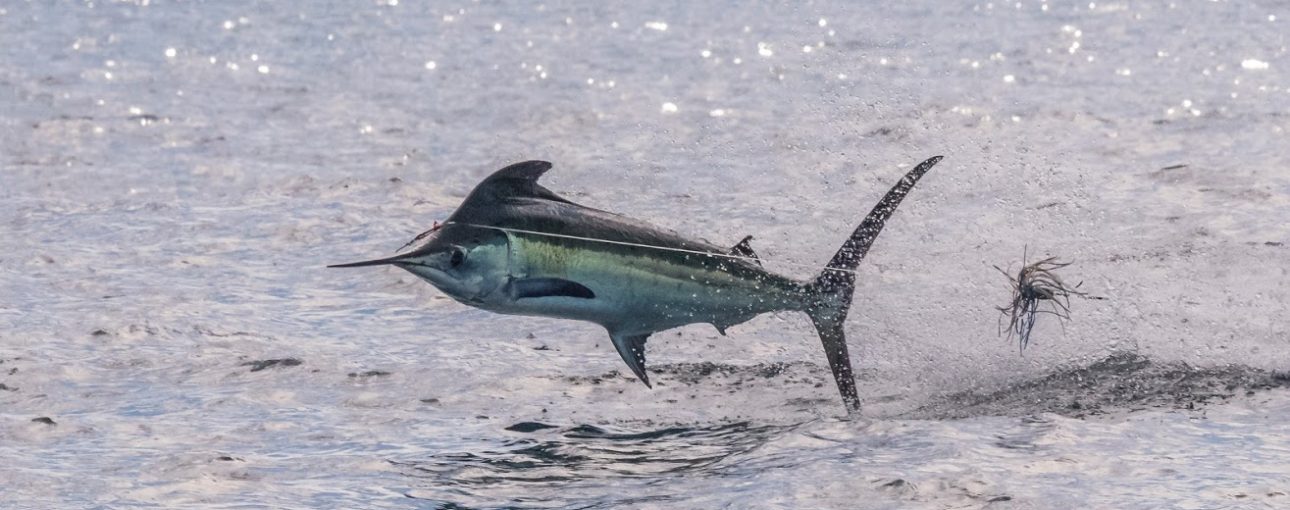Blue Marlin, unlocking the evolutionary secrets of an apex predator.
Most of us are somewhere between infatuated and obsessed with blue marlin, but unless you’re a billfish scientist, you probably don’t understand how these lightning-fast finely honed eating machines are able to swim thousands of miles, populate the vast tropical and subtropical oceans of the entire world, and detect and chase down the fastest, most elusive prey species — and to have done it successfully for literally millions of years. The short answer is incredibly engineered anatomy and physiology.
While all top-level fish hunters realize that detailed knowledge about one’s quarry is the key to finding it, getting the bites and converting them into captures, most lack exposure to many of the cutting-edge scientific advances that can give them an edge. I recently reviewed these during the course of writing a chapter about blue marlin biology and ecology for Capt. Steve Campbell’s outstanding book, Blue Marlin Magic. I was fortunate to interview and work with a number of the top scientists in the field, and the information they graciously shared blew me away.

The moment of truth, as a blue marlin is released at the boat. These fish have evolved over millions of years to become one of the ocean’s apex predators.
Austin Coit
The Billfish Evolutionary Tree
Professor John Graves, of Virginia Institute of Marine Science, shared with me results of DNA and morphological analyses he conducted with colleagues. Some of the billfish evolutionary tree we would all have guessed correctly — such as white and striped marlin being closely related, as are the four species of spearfishes. All billfish — marlin, spearfishes and sailfish — belong to the family Istiophoridae, with broadbill swordfish the sole species of the offshoot family Xiphiidae. Now, which billfish species would you guess is the closest genetic relative of blue marlin? I’d have guessed black marlin, but the correct answer is actually sailfish.
My next surprise came in reviewing just how long blues have been around. The branch of the billfish evolutionary tree we know as a blue marlin was sufficiently perfect that they are the most common billfish identified in fossil records dating to the late Miocene epoch. This means they were dominating their environment, worldwide, more than 12 million years ago. Sea levels were much higher than they are today. These fossils have been found scattered in locations as varied as Italy, Virginia, North Carolina, California and Mexico. To put this in perspective, we hadn’t even evolved yet — the closest things to humans roaming the earth were some humanoid apes. So the next time you feel humbled by a lit-up blue crashing your spread, you have every reason to be: They’ve been around for a very long time.

The gills of a blue marlin provide oxygen utilizing ram-jet ventilation. It is an incredibly efficient system for long-term endurance as well as for short, speedy bursts.
Will Drost
Satellite Tagging and Open-Ocean Behavior
Research scientist Michael Musyl provided a fascinating look at the incredible capabilities we are learning about blue marlin through pop-up satellite archival tags. Everything these creatures do is finely tuned, and the more we understand, the better we can adapt our techniques to encounter them more often. The continuous data produced by tagged individuals tells us their position, depth and ambient water temperature over considerable periods of time. Interestingly, some of this data only serves to confirm what far-flung artisanal fishermen independently figured out a long time ago. By the time Ernest Hemingway wrote The Old Man and the Sea, he was aware that the old Cuban hand-liners would set their baits deep — 300 to 800 feet — and catch blue marlin as well as big yellowfin and bigeye tuna. Meanwhile, Polynesian hand-liners were doing exactly the same thing, using rounded volcanic stones and a special slipknot to sink flying fish and other baits, in which a sharp tug on the line releases the weight. Modern-day swordfish and tuna longliners catch large numbers of blues by fishing dead natural baits much deeper than sport anglers. PSAT results tell us why, and suggest options for thinking outside the box.

[A] Eyes: Proportionate to their body size, blue marlin have the largest eyes of any billfish species, comparable to the eyes of a swordfish. Blue marlin also have the ability to heat their eyes using special cells, further increasing their visual acuity even in low-light conditions. [B] Bill: Thought to decrease hydrodynamic drag as well as provide improved feeding capability by stunning its prey, a marlin’s bill is covered with millions of rough denticles. [C] Inner Ear: A blue marlin’s tiny ear bones, or otoliths, can detect sound from long ranges and in a variety of wavelengths. Marlin have exceptional hearing. [D] Lateral Line: The fish’s lateral line uses sensory hair cells to trigger nerve responses and function as hydrodynamic receptors of low-frequency wavelengths emitted within two body lengths of the marlin. This allows them to sense prey and predators at close ranges, even in near-total darkness. [E] Gills: Blue marlin use ram-jet ventilation, pushing seawater past millions of tiny leaflike structures stacked along each gill filament to maximize oxygen extraction. The efficiency of this arrangement is unequalled in the animal kingdom. [F] Jaw: A predentary bone joins the tips of the two lower jawbones, allowing the jaws to open much wider than usually possible without coming apart. This allows blue marlin to consume very large prey, weighing as much as 10 percent of the marlin’s own body weight. [G] Dorsal, Pectoral and Pelvic Fins: With grooves and depressions along the fish’s body, a blue marlin can completely retract these fins for a more streamlined shape as needed. When extended, they give the fish incredible maneuverability. [H] Brain: A huge optic center processes information from the eyes, giving blue marlin excellent vision. They essentially see in black and white as they look down, but in shades of color as they look up toward the ocean’s surface. [I] Tail: A blue marlin’s extended tail lobes can reach water that is undisturbed by the passage of the fish’s body, making them extremely efficient swimmers.
Craig Smith
We now know that blue marlin spend much of their time easing along at 1 to 3 knots in warm, turbulence-mixed water above the thermocline, within a temperature range of 72 to 88 degrees, preferring a range between 75 and 81 degrees. However, during the daytime, they exhibit what Musyl calls a “W-pattern,” frequently diving to depths between 500 and 650 feet, and sometimes as deep as 2,600 feet. Stomach-content analyses show these fish are feeding on squid and deepwater fishes (“stuffing themselves” might be a better description), then surfacing to repay oxygen debts and warm up their muscles. Are island hand-liners and industrial longliners catching blues that are on their way down or perhaps swimming back up from these dives? Are there times and locations where large numbers of blue marlin are present but mostly feeding down near the thermocline? Would sport-fishing operations be far more effective drifting deep baits or presenting something completely different and yet-to-be-designed in the deep, such as large, scented soft plastics? Sometimes research raises more questions than it answers.
Recently, I was offshore of Islamorada, Florida Keys, out near the continental shelf drop-off, aboard my 20-foot SeaCraft. The sea was mirror-calm, and I spotted the dorsal and tapered tail lobe of a 250-pound-or-so blue marlin, motionless and flushed nearly black. We eased over and swam a schoolie mahimahi in front of the fish, which slowly sank out of sight in response. We circled, dropped live and dead baits: nothing. I wonder if it had just surfaced from a deep, cold dive, stuffed with prey, muscles oxygen-deprived, chilled to the bone, just trying to soak in some warm sun. I could almost hear the marlin say, “Are you kidding me?”

A marlin’s proportionally enormous eye is heated by special cells in the brain, allowing the fish to process images very rapidly, even in low-light conditions.
Scott Kerrigan / www.aquapaparazzi.com
The Eyes and Ears Have It
Imagine a blue marlin swimming in the cold, inky darkness. How do they effectively sense prey? For one thing, blue marlin have the biggest eyes in the billfish family, comparable to the enormous eyes of broadbill swordfish. Eye size is proportional to the capacity to gather light and other visual information. In addition, blues, like other marlin, swordfish and some sharks, have the ability to heat their brains and eyes using a counter-current exchange method and special warmth-producing cells contained in tissue located at the base of the cranium. The ability to process “frames per second” is proportional to heat, which gives these predators a huge advantage over schools of deeper-dwelling, slower-reacting prey animals that lack this heater organ.
Two other sensory apparatus also aid feeding capabilities: the inner ear and the lateral line system. The inner ear includes tiny otolith bones, which sense linear accelerations like sound waves, gravitational forces and body motion, and a canal system, which responds to angular accelerations of the head. The combination confers the ability to hear and also to orient in space. A marlin’s lateral line system, like the inner ear canals, operates by using sensory hair cells that trigger a nerve signal to the brain. These channels containing them run in networks down the sides of the body, and interestingly, the pattern of the network differs between Atlantic and Indo-Pacific blue marlin populations. They function as hydrodynamic receptors of low-frequency wavelengths from 10 to 200 Hertz being emitted within two body lengths of the marlin, which could come from prey, predators or even inanimate objects such as a fishing lure. It is highly likely that blues use their lateral line system to assist in close-range tracking and attacking of prey or lures. The inner ear system, on the other hand, detects sensations from much greater distances, such as the harmonic patterns in hulls and diesel engines, and sound-making knocks or rattles from a lure.

The fish’s lateral line allows it to detect small vibrations at close distances. A marlin can actually feel a dredge moving through the water.
Doug Perrine
Long-Range Marlin Migrations
Both PSAT and conventional tags have provided incredible advances in our knowledge of movements and migrations of blue marlin, and anatomy and physiology studies tell us how they do it. Worldwide, cyclic movement patterns occur in sync with migratory food sources or to prime feeding areas, followed by travel to spawning areas in which prey items may be relatively scarce. It’s interesting that some individuals make large-scale movements, while others might hang around a given area for extended periods of time. One blue tagged off of Delaware was recaptured in the Indian Ocean, near Mauritius. Another moved from the Tasman Sea off southeastern Australia to the Indian Ocean off southeastern India. Another individual tagged near Puerto Rico had its PSAT pop up 120 days later, 4,776 miles away, offshore of Angola, Africa. Others swam from Hawaii to Mexico, and to French Polynesia. Some blues circulate around the Western Pacific, and others between the Coral Sea off of northeastern Australia to the South Pacific islands. And then there are the homebodies, PSAT-tagged blue marlin that stayed in limited areas, such as Hawaii, the Gulf of Mexico, the Kuroshio Current system and the Caribbean Basin, for extended time periods.
What are the secrets that enable these incredible fish to accomplish all of this? Biologist Nick Wegner explained to me that seawater is far more viscous and oxygen-poor than air. Blues utilize ram-jet ventilation of seawater entering the mouth and flowing aft through the millions of tiny, leaflike structures called lamellae stacked in rows along each gill filament. Blood pumps counter-current (or forward, opposite to the water flow) through these highly vascularized structures to maximize oxygen extraction. The efficiency of this arrangement is unequaled in the animal kingdom.
Blue marlin anatomy contributes enormously both to efficient distance swimming and to burst speeds as high as 72 mph. Elongated tail lobes reach undisturbed water beyond the turbulence created by the body. The bill may provide a hydrodynamic advantage, and certainly, the grooves and depressions for folding the dorsal, pectoral and pelvic fins against the marlin’s body help significantly. I can remember so many times gazing down from the tuna tower of assorted boats I was captaining and marveling at the effortless swimming motion of that fusiform body, head relatively motionless as the scythe-like tail swept the body forward. Forty miles a day for these fish on a transoceanic journey? No problem. Explosive bursts exceeding highway speed limits? Easy.

Blue marlin are ambush predators, often appearing suddenly from the white water to crash a teaser, lure or bait.
Austin Coit
Marlin Feeding Behavior
We know from assorted studies that blue marlin are flexible, opportunistic feeders. Stomach analyses from around the world often indicate that blues have been feeding on primarily a single species, whatever they are following, or timing their migrations with which to coincide. Documented examples include chub mackerel off southern Portugal, skipjack tuna off southwestern Japan and bullet tuna off the Pacific coast of Mexico. However, the presence of other species indicates flexibility and opportunism, the marlin equivalent of, “Hey, we might be here to eat skipjack and smaller yellowfin, but if we run into a cloud of something else, we won’t turn it down.” Hence, we often find individuals packed with tiny filefish, puffers or triggerfish, or loaded up with deepwater fishes and squid.

A powerful tail gives the fish plenty of horsepower for dazzling aerial displays as a pair of remoras hangs on for the ride.
Jessica Haydahl Richardson
I experienced the other end of the scale working as a guide for Nomad Sportfishing, a seaplane fly-in mothership operation in northeastern Australia, where we put to good use the scientific fact that blue and black marlin have the jawbone adaptations and stomach elasticity and size to consume prey up to 10 percent of their body weight. We targeted school yellowfin, narrow-barred mackerel, and dogtooth tuna from 8 to 50 pounds for both live- and dead-rigged baits, and did not shy away from baits on the larger end of the scale. We regularly slow-trolled live yellowfin weighing 40 pounds and more, and had them slammed by huge fish. We also did things like drill longitudinal holes through full-size Boone Lu Lu teasers and rig them with 400-pound stainless-steel cable and a 12/0 single Mustad 7692 to form what was in effect a giant fat version of a cedar plug. They got crushed even by smaller blues, particularly around the sunken reefs and atolls out in the Coral Sea, such as Kenn, Wreck and Frederick reefs. And, of course, we all know how much those big Hawaiian blues like shortbill spearfis
How do they do it? One key element is a cap, called the predentary bone, that joins the tips of the two lower jawbones. Unique to billfish, this bone allows the jaws to open much wider than otherwise possible without coming apart. We observed big marlin flashing in and attacking whole live tuna, open-mouthed, like predators without bills. The hits were so hard that the bait would have to be stunned just from contact with the jaws. Nonetheless, there were also instances of marlin firing in and drilling the baits in the head with their bills. Campbell actually has a video of one such incident that occurred in Tonga.

From below, a marlin would see these rigged ballyhoo in shades of violet, blue and green.
Austin Coit
Color Schemes and Vision
Scientist Kerstin Fritsches, a leading authority on vision in billfish, enlightened me about key aspects of the way blue marlin see their world. The ability to detect, track and capture often very fast and elusive prey items contributes heavily to their evolutionary success. Blue marlin have eye muscles essentially identical to those of humans, which allow them to swivel and focus multidirectionally, yet their eyes are located on the sides of their head, so their vision is less binocular. They track items more often one eye at a time, and they possess high flicker fusion frequency, which means they can process a very fast rate of frames per second.
Perception of specific different colors requires the possession of a pigment, housed in a rod or cone, which is stimulated by the specific wavelength of the color, and this signal transmits to the giant optic lobes of the marlin brain. This has all been examined and tested with fresh eyes from specimens brought to the dock. The bottom line is that blue marlin see essentially in black and white with the dorsal portion of the retina (the portion that looks down, into the darkened depths), and they can see as color mostly shades of violet, blue and green with the ventral part of the retina (the part that looks up into the sunlit layers). Other fish, such as freshwater trout, can see the full color spectrum in a manner similar to humans. This means a blue marlin would see red as black, and various other colors as perhaps shades of gray. They still see them as different shades, but not in the way we humans do. Remember that
they are perfection incarnate in their environment, so whatever they see, and however they see it, is the pinnacle of millions of years of evolution.
About the Author: Capt. Scott Bannerot has worked in professional fishing since 1976. He earned his Coast Guard captain’s license in 1982 and a Ph.D. in marine biology from the University of Miami in 1984, and has worked as a charter captain, author and scientist in the Caribbean, Central America, South Pacific and Australia, with home base always in Islamorada in the Florida Keys.
Related Costa Rica Fishing Articles
Planning A Memorable Costa Rica Fishing Trip
Stop Illegal Fishing in Costa Rica
Costa Rica Marlin Tagging Project a Success
Why Costa Rica is the Perfect Destination to Take the Kids Fishing



















